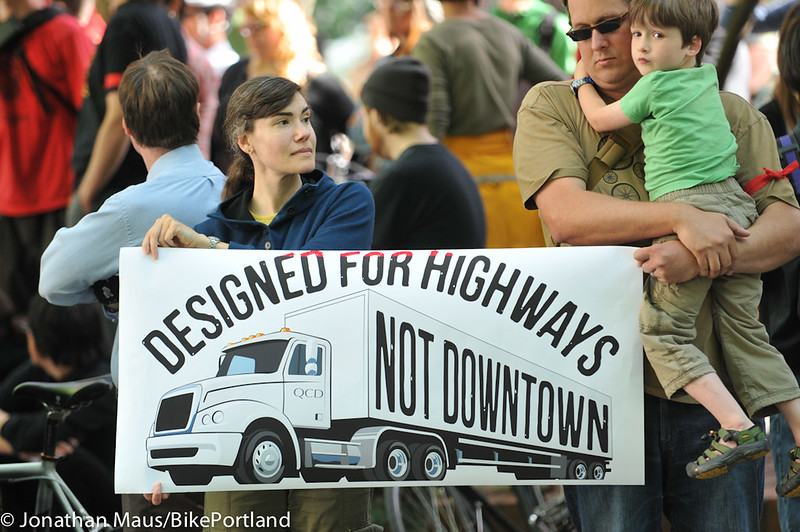The dangerous combination of right-hooks and large trucks have been one of the most pressing bike safety issues in Portland for the past a decade. We have lost far too many people because of this deadly combination.
So why aren’t we doing more about this well-known hazard? Like so many of Portland’s bike-related projects, the solution is in the city’s plans, but not in the city’s budget.
We were once again shaken out of our complacency with this issue when a man died while bicycling on North Interstate Avenue yesterday. Official details are still sparse, but it has all the trappings of a classic right-hook.
That horrible tragedy is just the latest in a long line of them.
In 2007 Brett Jarolimek and Tracey Sparling were killed within two weeks of each other when a truck operator failed to see them, turned right, and ran over their bodies. It happened again in 2012 to Kathryn Rickson on a busy bike lane just one block from City Hall.
After all three of those tragedies one of the main responses from the community was the need for safer trucks.
But for some reason we haven’t made enough progress. There have been tiny steps here and there, but the deadly duo of large trucks and intersections still looms ominously above us all.
If you use our streets on foot or on bike, the danger is palpable. You can feel the rumble of a large truck and watch with foreboding as its wheels and undercarriage pass you by.

The crash almost immediately led to the discussion of one specific truck safety measure: side guards. The simple and cheap technology simply attaches a shield of material (or steel rails) between the front and rear axles. The idea is that if a human — in a car, on a bike, on foot, or any other conveyance — comes into contact with the side of the truck they’ll be pushed outward and away, instead of under the weight of the truck’s wheels. The research of their benefits (which also include fuel savings thanks to improved aerodynamics) are conclusive. According to a U.S. Department of Transportation-funded Volpe initiative, use of truck side guards in the United Kingdom led to a 61 percent decrease in bicycle fatalities. In 2014 the National Transportation Safety Board issued a recommendation to the National Highway Traffic Safety Administration that all trucks should use them (but unfortunately it’s non-binding and Congress still hasn’t taken up the cause).
Other cities like New York City, Boston and San Francisco have jumped on side guards as a way to make streets safer and fulfill commitments to Vision Zero. And just six days ago the Seattle Department of Transportation announced they will equip all trucks in their city fleet with side guards.
What about Portland?
Advertisement
“Currently, there isn’t funding, but PBOT and BPS [Bureau of Planning and Sustainability] have been working on identifying resources to retrofit all fleet vehicles and for opportunities for education.”
— John Brady, PBOT communications director
In October 2007, as an emergency response to two deaths, the Portland Bureau of Transportation offered three “potential equipment solutions” for large trucks: one of them was side guards. That initiative led to at least a few side guards being installed on Portland Water Bureau trucks. (The Water Bureau has been a leader in truck safety. They held a bike/truck safety event in September 2008 and released a bike/truck safety video in October 2008.)
Other than that, I’m not aware of any major equipment initiative at the City of Portland to improve truck safety.
After yesterday’s fatality, we took a look at the Portland Bureau of Transportation’s recently passed Vision Zero Action Plan. Truck equipment upgrades are mentioned as one of seven action-items in the Dangerous Behaviors section.
Here’s the text of action D.7:
Develop and implement safety measures on heavy trucks owned or contracted by the City, including but not limited to truck sideguards, sensors, additional mirrors, educational messaging and enhanced driver safety training.
Phase I: Education outreach for all and City fleet upgrades;
Phase II: City contractors and service providers install truck upgrades
The above measures are listed as actions to be taken within five years (as opposed to two years for higher priority actions).
Asked about the status of the action, PBOT Communications Director John Brady wrote via email, “Currently, there isn’t funding, but PBOT and BPS [Bureau of Planning and Sustainability] have been working on identifying resources to retrofit all fleet vehicles and for opportunities for education.” In a follow-up question, Brady said PBOT doesn’t have an official cost estimate yet. However, in their contact with other agencies they have heard the costs run about $3,000 per vehicle.
Brady said PBOT is also working with other city bureaus and with truck operators who drive in Portland, “because we recognize the increased risk associated with crashes that involve heavy trucks.” As an example, Brady cited a driver safety program in the Bureau of Environmental Services’ construction division. That educational program teaches drivers about road hazards and safe driving practices. “They have compiled a list of the 120 contractors, subcontractors and suppliers that are working on their $75M in construction projects and are traveling throughout the Portland metropolitan area to present this driver training course and distribute Vision Zero safety tips, hard hat stickers and bumper stickers that remind drivers about right hook risks,” Brady shared.
Keep in mind that absent a new federal law, the City of Portland can only require equipment options on their own fleet vehicles.
— Jonathan Maus: (503) 706-8804, @jonathan_maus on Twitter and jonathan@bikeportland.org
BikePortland is supported by the community (that means you!). Please become a subscriber or make a donation today.
*Infographic on side guards below is from Volpe/USDOT




